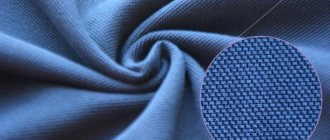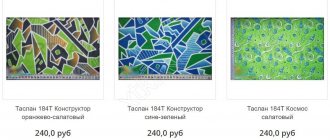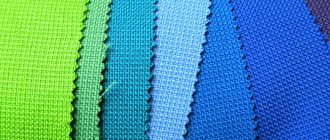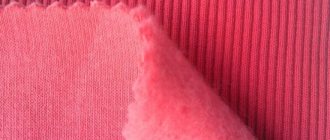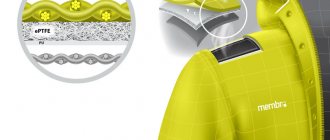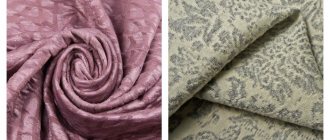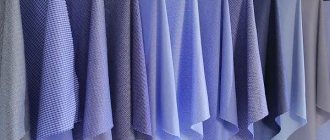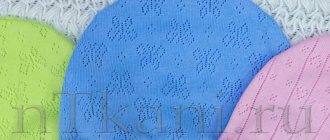Melange fabric - what is it?
Melange is a fabric that is created by combining fibers of different colors into a fabric.
They can be natural or artificial, twisted or simple, but always in different shades. Translated from French it means “mixing”, “stirring”. Initially, melange was obtained by weaving cotton or linen fibers. Since they were unprocessed, the resulting fabric was a combination of different shades of gray and beige in one fabric. It was noted that it is dense and also lasts a long time.
Then production was mechanized and they began to use not only raw cotton threads. Now melange is made:
- from wool, for example, angora;
- natural threads with the addition of synthetics - lavsan, viscose, elastane, nylon, nylon;
- waste from yarn production;
- flax;
- cotton;
- connecting fibers of different types to each other.
By using threads that are similar in tone, a characteristic melange color is obtained. For example, this is blue with blue, white with beige, red with crimson, etc. This is a gradient coloring - dark shades smoothly flow into light ones and vice versa. Because of this, things look somewhat voluminous, elegant and expensive.
Another production option is to use threads of different colors as a basis. For example, black and white, green and blue, yellow and red. The fabric can be woven from 2, 3, 4 multi-colored fibers. This method of staining is called contrast. The result is bright products that can improve your mood in cloudy weather.
To see what the fabric looks like:
Combination of anthracite color with other colors
Anthracite color belongs to the basic set of shades. It is neutral, and its dark component always symbolizes shadow and depth. The shade enhances the effect of other colors due to its violet undertone. Anthracite is a cool tone, and its combinations are often based on warm-cold contrast. As a dark color, it interacts with shades of light. As a complex, multi-faceted shade, it can highlight the beauty of tones as intricate as itself.
The combination of anthracite and pink is usually bright and expressive. To do this, take light lilac shades or tones close to fuchsia. Cool tones of pink harmonize the image, protect it from thermal contrast, which, next to brightness and light, will look unnecessary. For example, consider a combination with white-lilac, lilac, fuchsia, amaranth, and clover.
How to combine anthracite and red? A bright, warm red tone practically glows against a dark gray background, but you should not take deliberately bright shades; complex muted, cold tones will be more advantageous in this combination, for example, the color of a red rose, carmine, ruby, bright burgundy, wine.
Anthracite combines with orange in a subtle autumnal way. The natural tones of orange reveal their warm and vibrant essence, warming and seeming to glow against the dark, cloudy anthracite. It is worth choosing muted, complex tones, such as peach, coral, ocher, copper, red.
The color combination: anthracite and yellow is bright, even provocative, but yellow looks like the sun peeking out from under a cloud. He pleases and inspires. Shades of yellow should be selected with a slightly orange undertone or gold. Glitter in such a composition will always be appropriate. The colors used in the palette were apricot, saffron, mustard, yellow gold, and bright gold.
Anthracite color and warm green are an expressive combination, with warm-cold and bright contrast. Moderately pure shades of green flourish against the background of the main tone and at the same time they are supported by the contrast of dark color. For example, consider a combination with polka dot, light green, olive, swamp green, dark green.
The combination of anthracite and cool green is based on brightness and light contrast. These are dark or medium emerald tones that take on a mysterious, thick aura due to the base color. The combination looks prestigious. The table of combinations uses light gray-green, wormwood, patina, emerald, and malachite.
Anthracite and blue are a combination of calm, strong colors. Shades of blue with a barely noticeable admixture of violet glow against an anthracite background, while medium and dark blues flow harmoniously into each other. The purple undertone helps bring the shades together. So the tones of baby blue, cornflower blue, royal blue, sapphire, cobolt are suitable for this combination.
The combination of anthracite and purple is smooth and graceful. Violet colors are closest to the main tone, so the combination looks flowing and has the least contrast. Purples with red undertones, such as thistle, amethyst, blackberry, plum, eggplant, softly continue the anthracite color.
Anthracite combines with brown in an intricate, vintage way. This range looks noble: earthy brown and heavenly anthracite are combined without unnecessary bright contrasts, but both are complex, multifaceted and natural. Thermal contrast is what gives this combination its strength. The palette includes the colors cocoa with milk, cocoa, golden chestnut, mahogany, and chocolate.
The combination of anthracite with white, beige, gray, black - neutral shades, forms a capable, noble base. With white - a businesslike, stylish pair, with beige - a subtle, feminine look, with gray - a natural, free look; with black – deep evening color. Shades of primary colors that look more harmonious with our tone: creamy, latte, beige, taupe, black.
Minerals
| Contents per 100 g of product | Sodium, mg | Potassium, mg | Calcium, mg | Magnesium, mg | Phosphorus, mg | Iron, mg |
| Melange | 134,00 | 140,00 | 55,00 | 12,00 | 192,00 | 2,50 |
Related publications
- Grain exports from seaports increased by 25% - 10/09/2018
- Test tube meat is a real threat to the feed industry - 10/08/2018
- A new version of bird flu discovered in China - 09/28/2018
Next article
- How to choose the right chicken eggs: expert advice - 01/17/2017
Advantages and disadvantages of fabric
Advantages of melange material:
- abrasion resistant;
- wears for a long time;
- wide variety of colors.
Additives in fabrics impart various positive properties to fabrics:
- synthetic threads - elasticity, stretch, shine, durability;
- cotton – the ability to conduct air to the skin, lightness;
- Wool helps to retain heat and keep you warm.
Negative qualities of melange fabric:
- shrinks if made from natural fibers;
- stretches when the base is knitwear;
- deteriorates when exposed to hot temperatures;
- the presence of wool in the composition exposes the products to the risk of being damaged by moths;
- requires care.
See fabric review:
How to make the right choice
So, you are ready to buy melange. You already understand what it is, now we will learn to make the right choice of a quality product. Pay attention to the elasticity of the thread, its strength, twist, and uniformity of coloring. If the thread is too twisted, it will not be suitable for knitting. It is designed for crocheting. Also, the finished product may turn out to be skewed, and no amount of ironing will save it.
The elasticity of the thread is checked quite simply: pull it, if it springs, then you have a quality product in your hands. It is very important that the melange thread does not have thickenings. Read the label carefully. It must indicate the percentage of different fibers, the length and weight of the thread, recommendations for choosing knitting needles and knitting density. These recommendations should not be ignored; they are given by experienced specialists from manufacturers based on numerous tests. Knitting melange is a fun and interesting activity.
What to do with purple?
Purple is a mixture of red and blue, two opposites, elements. However, purple is unique for its calming effect on the human psyche, its harmonious and attractive appearance.
This color is good for women, especially creative, pregnant, romantic, young and mysterious women.
Clothing in purple colors goes well with:
- yellow;
- orange;
- white;
- with lighter or darker shades of the same purple in one look.
For a meeting it is good to match purple with black, and for a romantic walk – with white.
For fair-haired or fair-haired girls, lilac, lilac, the color of grapes or ripe plums will look especially touching, and if you are a brunette, then an almost inky color, rich blueberry, thick indigo color will look good.
To avoid overdoing purple, don't pair it with red or green.
↑ return to table
Application and care
Comfortable and practical melange is perfect for creating casual street style clothing. Comfortable coats and suits, dresses and trousers are made from it, various accessories are made, and used as furniture upholstery.
Caring for such fabrics is not difficult, but it has its own characteristics and directly depends on the fibers that make up the fabric.
- Hand and machine washable in warm water.
- Products should be ironed from the inside out in a mode corresponding to those fibers that melt more easily.
- Dry in places protected from direct sunlight.
Melange fabrics are not only comfortable and practical, but also incredibly beautiful. Clothes made from this fabric can decorate the wardrobe of the most discerning fashionista.
To learn how to dye threads at home, watch the video.
In French, the word "melange" refers to a mixture of different ingredients. This term is used in the food and confectionery industries, as well as in the production of yarn and fabrics. Melange yarn is well known to needlewomen, and variegated fabrics are widely used for making clothing and household items and never go out of fashion.
Application in the interior
Melange can look different every time. Its external parameters change dramatically depending on the incidence of sunlight and viewing distance. Even shiny fabric with sequins or lurex cannot boast of such an effect.
The surface of melange textiles is characterized by the presence of tubercles and irregularities. The described property adds an additional decorative effect. The delicate and soft fabric looks fleecy to the touch, which is why it is used in the interior.
The melange textile group is developed based on the following materials:
- cotton;
- flax;
- synthetic fibers.
Melange fabric in the interior
Due to its high wear resistance, melange fabric is used in the production of upholstery for upholstered furniture, rugs, covers for armchairs or sofas. Light and dark yarns are used to complement certain styles of interiors. These include:
- antique style. Used to create tapestries, runners in wine colors and matching furniture upholstery;
- Bauhaus. Melange covers with a gradient color in a neutral color combination;
- Biedermeier;
- boho. Variegated fabric is used to create bright splashes;
- avant-garde - a new look at practicality;
- Gzhel - blue palette paired with cool tones;
- grunge Natural melange without synthetic fibers, etc.
You might be interested in what is the best material to make underwear from: choice of fabric
The use of melange is not only a practical move, but also an excellent statement of design solutions.
Melange pillows
Melange
(from French melange - mixture)
1. the same as Melange yarn.
2. Same as melange fabric.
(Terminological dictionary of clothing. Orlenko L.V., 1996)
* * *
French - mixing different colored fibers in yarn; fabric made from this yarn.
(Encyclopedia of fashion. Andreeva R., 1997)
Source: Encyclopedia of Fashion and Clothing on Gufo.me
Meanings in other dictionaries
- MELANGE - MELANGE - in chemistry - a mixture of concentrated nitric and sulfuric acids with a volume ratio of approx. 9:1. Used in the production of sulfuric acid using the tower method. MELANGE (from French. Big encyclopedic dictionary
- melange - egg MELANGE (from the French melange - a mixture, egg mass, preserved by freezing. M. is made from standard fresh or refrigerator eggs received from farms, free from infectious diseases. Agricultural Dictionary
- melange - -a, m. special. 1. Yarn or fabric made from mixed fibrous materials of different nature or color. 2. Frozen egg mixture, which is a substitute for fresh eggs. [From French mélange - mixture] Small Academic Dictionary
- melange - melange I m. 1. Yarn or fabric made from mixed fibrous materials of different manufacture, quality, and coloring. 2. decomposition Products made from such yarn or fabric. II m. Frozen mixture of egg yolks and whites, used in catering establishments and in the confectionery industry. Explanatory Dictionary by Efremova
- melange - Melange/. Morphemic-spelling dictionary
- melange - MELANGE, a, m. (special). Yarn made from a mixture of fibers dyed in different colors. | adj. melange, oh, oh. Melange fabric. M. combine. Ozhegov's Explanatory Dictionary
- melange - Melange, melange, melange, melange, melange, melange, melange, melange, melange, melange, melange, melange Zaliznyak's Grammar Dictionary
- melange - I. MELANGE I a, m. mélange m. 1. Mixing fibers dyed in different colors in yarn; also fabric produced in different colors; also fabric made from such yarn. Melange yarn. Bike melange. Melange cloth. BAS-1. Cloth yarn, melange. Dictionary of Gallicisms of the Russian language
- melange - MELANGE -a; m. [from French. mélange - mixture] 1. Special. Yarn and fabric from fibrous materials of different nature or color. 2. Scrambled eggs from eggs beaten with salt and milk; omelette. Make a m. on pork. M. with sausage, ham, herbs. Kuznetsov's Explanatory Dictionary
- melange - (French melange - mixture). A mechanical mixture of egg whites and yolks, without maintaining their exact ratio, sometimes frozen and stored in briquettes. Culinary dictionary
- melange - spelling melange, -a, tv. -em Lopatin's Spelling Dictionary
- melange - noun, number of synonyms: 5 breccia 6 breed 278 yarn 23 mixture 89 fabric 474 Russian synonym dictionary
- Blog
- Jerzy Lec
- Contacts
- Terms of use
© 2005—2020 Gufo.me
Melange - what color is it
It is impossible to determine what color melange it is. In reality, such a tone does not exist at all. This term refers to melange yarn consisting of multi-colored fibers.
Blue melange
Thus, melange is a woven fabric that is formed by using single-strand or twisted yarn from fibers (threads) that differ in color. The shade of the raw material can be contrasting or vary in tone.
The finished result is a fabric with a specific pattern that resembles polished marble tiles. The higher the contrast of the fibrous elements, the more expressive the textile becomes. Depending on this, two main types are distinguished:
- "Grainy". Up close it looks colorful, but from a distance it takes on one shade.
- "Gradient". All tones of the same color smoothly transition into one another.
Melange burgundy
Each company produces melange fabric using different technologies and methods, and color combinations also differ.
Gray melange and other colors
Gray melange is the most popular type of fabric. The more common option is with dark accents.
This true classic has the following advantages:
- restraint;
- a harmonious ensemble with all color spectrums.
The color gray melange looks beautiful with other shades, highlighting them favorably:
- apple and salmon, which creates a sensual and sweet composition;
- carmine and alizarin, adds some dramatic effect;
- orange, tangerine, powder - active sunlight is neutralized.
Attention! Gray melange material is used in clothing. All winter sweaters and sweatshirts from mass market stores are made from the described fibers.
Gray melange
Anthracite melange
Anthracite is a sophisticated color reminiscent of wet asphalt. It is used in clothing design, but still looks stylish in interior solutions.
Interior designers place emphasis on:
- warm colors with yellowness;
- gray pearls;
- shiny grey.
Interesting! Anthracite melange color sets off the bright elements in the room and presents all elements in a new favorable light.
Anthracite melange
Melange beige
Beige melange is most similar to skin color. Flesh color is divided into several spectrums, which are combined in their own way with other shades.
Beige goes well with the following colors:
- royal pink, sunset pink, lilac, fuchsia and raspberry. Warm shades complement and create a pastel cozy color scheme, cool shades create a warm-cold contrast;
- scarlet, coral red, ruby, wine and burgundy. This ensemble celebrates red as a new color and ignites the fire;
- peach, coral, golden, copper and red;
- pale yellow, sunny, banana, saffron and gold;
- warm and cool greens (pistachio, chartreuse, olive, khaki, emerald and malachite).
For your information! Beige also pairs spectacularly with blue and purple tones, creating a clashing ensemble.
Peach melange
Blue melange
Blue melange is a very original combination of aristocracy and practicality. Depending on the color pairs, the blue palette takes on a new light:
- to create thermal contrast, peach, soft pink, scarlet, Chinese red, wine, red zirconium and roses, mango, apricot, and curry are used;
- a cool, harmonious combination of blue looks impressive with apple green, pine, neon green, malachite and pale menthol.
Purple melange
A harmonious combination with a neutral palette always looks advantageous.
Melange color - what color is it? Description
What is melange?
The word "melange" is translated from French as "mixture" and has a wide range of applications. The term is used in chemistry, cooking, geology, rocket science and even in needlework. For example, in the coffee industry, “melange” is an espresso-based drink with milk and cream.
Melange yarn
Melange color
If we talk about a color with this name, then it actually does not exist. The expression “melange color” means melange yarn, which consists of multi-colored fibers that are similar in tone.
Melange yarn can consist of wool, cotton or artificial threads and have different textures. You can make melange yarn yourself or buy it ready-made in a store, fortunately there is a huge selection now.
Items made from melange yarn have no restrictions on style, cut and color shade. These are mainly knitted clothes; they hold their shape well. Dresses, jumpers, cardigans, coats made of melange yarn, as well as various accessories, such as scarves, look elegant.
Melange fabric
Melange fabric is a fabric made from fibers dyed in different colors. Variegated fabrics are used for sewing outerwear, casual wear, and home textiles.
To create melange fabrics, the following types of raw materials are used:
- plain cotton yarn
- a mixture of dyed cotton fibers;
- natural wool, dyed and undyed;
- artificial and synthetic fibers, for example, lavsan, nitron, nylon.
melange fabric photo
By combining these starting materials, you can get many different fabrics that differ from each other not only in appearance, but also in properties.
Melange fabric has an amazing quality - the ability of the canvas to always look different, depending on the lighting and distance.
Shades of melange
Melange gray
Gray melange - what color in clothes? The most popular is gray with dark splashes. This shade is considered a classic, it is discreet, combines harmoniously with almost all colors, softly shading clothes.
Clothes made of gray melange (what color this is is described above)
Other options are blue and light blue, green and light green, brown and beige. Such combinations look great both in wardrobe items and in interior elements, giving it comfort and originality.
Gray melange shades look elegant and impressive in everyday and business looks. Gray melange, a color so universal that it will suit both young girls and mature ladies.
It wasn't always like this. There was a time when gray was considered the color of clothing for the poor. He was considered boring and uninteresting. It was worn by those who could not afford colored fabrics, for example, governesses. Later, famous fashion designers (Courreges and Dior) considered the zest in this color, appreciating it. Gray has many shades - silver, pearl, smoky. True, you need to choose this color for clothes wisely so as not to look like a gray mouse.
Combinations in clothes with melange
Gray melange with other colors
The main rule of combining gray melange with other colors in clothes is not to turn into a gray spot. Therefore, when combining things, try to proceed from the rule: light top, dark bottom” or “dark top, light bottom”.
In general, melange of any shade looks good with black. Beige goes well with gray melange.
Pastel colors will do. In such combinations, melange acts as a background. Cool shades look advantageous with dark melange - soft blue, lilac, mint, pale pink.
Light gray melange looks great in combination with pink, pale yellow, peach, and light green.
In addition, gray melange can be combined with red, yellow, pink, and green. The main thing is to make sure that the shades look harmonious on you.
What color is beige melange?
Beige is closest to skin color. There are about a thousand shades of beige in the world. Beige melange is divided into different shade groups, each of which goes well with certain colors.
For example, gray-beige harmonizes with fuchsia, amethyst, ruby, emerald, brown, silver, azure.
Light beige melange - what color is it? It looks like milk, belongs to the classics along with black and white, and goes with almost all colors.
Pinkish beige, sometimes called powdery, is warmer, and most importantly - versatile. It will look most advantageous with lilac, brown, gold and silver.
Anthracite melange - what color is it?
This word translated from Greek means “coal”. Therefore, anthracite melange is called a deep and dark shade of gray. Sometimes called wet asphalt tint
This color is most suitable for formal business style outfits. However, pure anthracite melange can look somewhat gloomy, so it is usually diluted with other, brighter shades. For example, red.
Anthracite successfully sets off the bright shine of jewelry.
You need to be careful when combining anthracite melange with dark, deep shades; the image can turn out gloomy. Almost all shades go well with anthracite melange: pale pastels, white, beige, malachite, black and, of course, lighter shades of gray.
Fashionable palette London autumn-winter 2020-2021
Now let’s take a quick look at London’s fashion palette.
As you can see, the shades Samba, Military Olive, Ultramarine Green and Sleet coincide with the New York palette. There are even more shades that have different names, but are very similar visually: Exuberance is an analogue of Amberglow, True Blue has something in common with Classic Blue, Burnt Henna has something in common with Fired Brick, Tawny Birch has something in common with Sandstone, etc. And in general, both palettes turned out to be very close in spirit and mood.
To sum it up, even color trends show a completely new approach to fashion: from fast fashion (fast fashion) to more durable and sustainable options. So you can confidently adopt these color palettes, since these shades will serve you for more than one season.
Author: Ekaterina Malyarova Image maker, creator of image and style training, author of the website Glamurnenko.ru. Since 2007, over 500 clients have gone shopping with me. More than 5,000 people attended trainings and seminars on image and style.
Anthracite color in clothes
Anthracite color in clothing, as a base tone, is found in outerwear, business suits, bags and shoes. It can be easily combined with other colored wardrobe elements, easily changes your style, and is multifunctional. It can be business, elegant, cozy, evening - it all depends on what element, what color is next to it.
Anthracite has other advantages in clothing: it does not stain, it slims the figure, its dusty tone perfectly emphasizes the discreet beauty of the “summer” color type, and the purple undertone favorably sets off the “autumn” color type.
Of course, anthracite is most often found in autumn fashion collections as a dark, complex tone, but its use is closer to seasoned classics.
The nutritional value
Vitamins
- A Vitamin A 0.25 mg
- PP Vitamin PP 0.2 mg
- Beta carotene 0.06 mg
- A (RE) Vitamin A (RE) 260 mcg
- B1 Vitamin B1 0.07 mg
- B2 Vitamin B2 0.44 mg
- B5 Vitamin B5 0.5 mg
- B6 Vitamin B6 0.4 mg
- B9 Vitamin B9 8 mcg
- B12 Vitamin B12 2 mcg
- E (TE) Vitamin E (TE) 0.6 mg
- H Vitamin H 3 mcg
- PP Vitamin PP (NE) 3.6 mg
- Choline 70 mg
Macronutrients
- Fe Iron 2.5 mg
- Zn Zinc 3 mg
- I Iodine 7 mcg
- Cu Copper 180 mg
- Mn Manganese 0.035 mg
- Cr Chromium 10 mcg
- F Fluorine 63 mcg
- Mo Molybdenum 12 mcg
- Co Cobalt 7 mcg
- Ni Nickel 10 mcg
- Sn Tin 75 µg
Famous workers
- Boytsova (Anfinogenova), Vera - awarded the Order of Lenin.
- Erofeeva, Anastasia Fedorovna - Hero of Socialist Labor. Delegate to the 25th Congress of the CPSU.
- Sokolova R.F. - Hero of Socialist Labor.
- Saraeva V.V. is a full holder of the Order of Labor Glory.
Five employees of the plant were awarded the title of Hero of the Soviet Union on the fronts of the Great Patriotic War:
- Shvetsov, Ivan Ivanovich
- Babanov, Ivan Dmitrievich
- Dubrovin, Mikhail Yakovlevich
- Stolyarov, Alexander Nikanorovich
- Sakharov, Pavel Ivanovich
( 2 ratings, average 5 out of 5 )
What is inconvenient about the original product?
Anyone who has bought eggs at least once in their life (and only very foolish children do not fall into this category) knows how easy it is to damage them and how difficult it is to bring them home intact. Moreover, they, unfortunately, are stored quite little. At night in the summer we turned off the lights - and the next morning we have an unpleasant smell in the refrigerator, as well as food that is completely unsuitable for cooking. And even if stored correctly, eggs may not be of very high quality, because they could have been transported under inappropriate conditions, as a result of which the white and yolk inside were mixed. You break an egg, and instead of the necessary contents, you get the same foul-smelling mass. That is why in production, where such (but fresh!) ingredients are needed in large quantities, they prefer to use egg melange or powder from the same material. Among other things, the use of both derivatives greatly reduces the cost of the industrial baking process, since their creation involves substandard ingredients—broken, small eggs that have lost their integrity or presentation.
Walls in anthracite color
Gray has not been an easy color to use in interior design for a long time. For many, it was considered boring and banal, and its dark shades were considered gloomy and depressing. However, when, after years of pastel dominance, strong colors storm the walls of apartments, anthracite color has every chance. This is due to the blossoming popularity of Scandinavian style interior design. His color palette is based, among other things, on a mixture of gray and white. Additionally, according to color psychology, dark shades of gray convey an impression of security, calm, balance, wisdom and durability. For this reason, anthracite walls are ideal for a study, studio or office, bedroom, living room or bathroom. They will be the ideal basis for modern interiors.
For anthracite color, choose a wall that is best visible in the room. It should be located either opposite a large window, terrace, veranda, or in close proximity to the glazing (for example, perpendicular to the windows). Thanks to different light levels, the anthracite color of the walls changes its character throughout the day. In the morning it is more cozy, and in the evening it is a little more severe. Depending on which embodiment of the color character you prefer, you can paint the wall a more or less dark shade of anthracite.
Of course, anthracite is not just a color. In stores you can also find designer wallpapers of this color, often painted with floral, geometric or abstract patterns. Anthracite color in the interior has also gained recognition due to the popularity of the so-called “board paint”. The surface covered with it can be used at home or in the office, as an office board for sticky notes or for drawing. Soft chalk designs and writing can be easily erased when no longer needed. With its help you can paint not only walls, but also almost any surface of the apartment. Although board paint is available in many varieties, anthracite has made the biggest splash. First of all, because it is associated with the classic school board.
What can you knit from melange
Melange yarn is in great demand among needlewomen. With it they can realize their most interesting ideas. Due to the play of colors, the shortcomings of the knitting itself are smoothed out. This yarn allows you to make beautiful patterns without much effort - the unique color combinations will do it themselves.
You might be interested in what suprem is: fabric features
Melange is always relevant for both female audiences and men's and children's audiences. It is used to knit: pullovers, sweaters, sweatshirts, vests, swimsuits, scarves, hats, bedspreads, toys, etc. If the brightest colors are often used in children's and women's clothes, then for men they mainly use black, gray and blue shades.
Knitters who have pets enjoy sewing costumes for them. Decorating your home space with knitted items (for example, rugs, rugs, pillows, tablet cases) is very popular.
Products made from melange yarn always look original.
Melange yarn
( 2 ratings, average 4.5 out of 5 )
"Anthracite" in the interior
It looks laconic and stylish, you can experiment with it, highlighting brighter shades. As a primary color, it imparts rigor and restraint, but at the same time does not disturb the comfort of the room.
Anthracite is suitable for rooms where there is a lot of light. If the apartment is dark, it is better to choose a lighter shade of gray.
Many shades in the interior are combined with the color “anthracite”. Let's give a few examples.
White
– an ideal companion for anthracite. These shades can be combined in any proportions, for example, one wall can be made white and the adjacent one can be anthracite.
Brown
in combination with charcoal gray - a universal option. The room looks strict and elegant. Light shades of brown are often used to decorate bedrooms, living rooms and kitchens.
Black
in combination with anthracite it looks stylish. Both shades are neutral and complement each other. However, such a duet should not be present in the room in large numbers, so as not to create a gloomy atmosphere.
In modern interiors you can try combining it with sand, terracotta, milky white.
Popular types
In the first years of production of melange fabric, coarse unprocessed cotton of various shades, which was called gray linen, or motley, was used as a raw material for its production. It was not very beautiful, but cheap and durable material. Later, raw linen began to be made from higher quality threads, after first cleaning and mercerizing the fibers. Cotton variegated fabric is still produced today.
In addition, the following types of wool melange textiles are produced.
- Drape melange. Dense and durable fabric used for making winter outerwear. It can be two-color or multi-color, smooth or fleecy.
- Melange cloth. Warm woolen material, thinner than drape. Used in the production of suits for everyday wear.
- Cheviot. The fabric consists of wool fibers, sometimes with a small admixture of cotton. The fabric is in demand when sewing skirts, trousers,...
- Tights. Material for sewing trousers and tracksuits.
- Covercott. The canvas is distinguished not only by its melange coloring, but also by its special pattern with a characteristic scar.
Fabrics with a mixed composition can be divided into a separate group. Adding a synthetic thread that differs in color and texture to the base creates not only a special color scheme, but also makes the surface of the fabric more prominent. In addition, combining synthetics with wool or cotton significantly improves the performance properties of the fabric: strength, wrinkle resistance, and lack of shrinkage.
History of color
When used correctly, melange looks rich and impressive. However, this was not always the case.
Clothes made of gray melange were worn only by the poor, who could not afford luxurious satin or soft silk. For example, cleaners, traders, servants.
Then the production of melange (petstryadi, at that time) took place through the processing of coarse cotton. It wasn’t particularly visually demanding, but it could easily compete in strength.
History of the creation of melange
At the end of the twentieth century, famous fashion designers saw in the material not only practicality, but also beauty. Thus, melange fabric appeared in many collections in all sorts of variations.
Nowadays the following are used to create fibrous:
- cotton yarn;
- dyed cotton fibers;
- natural wool;
- synthetic fibers.
Its main advantages are the huge variety of colors and excellent performance properties. Due to this, melange is used in many industries.
You might be interested in Features of silk-screen printing on T-shirts and other fabrics


